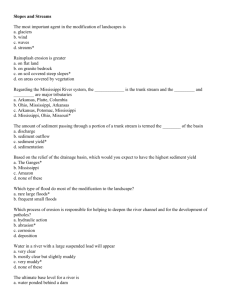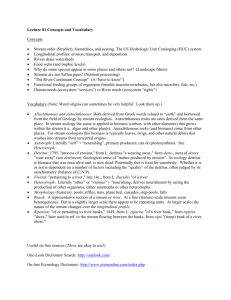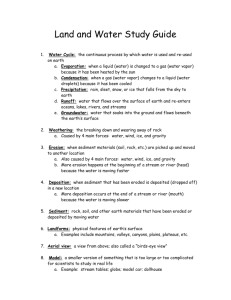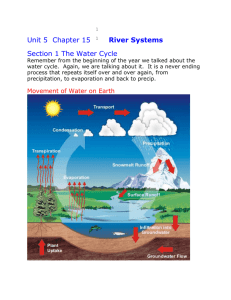GEOL-1403-McMahon
advertisement
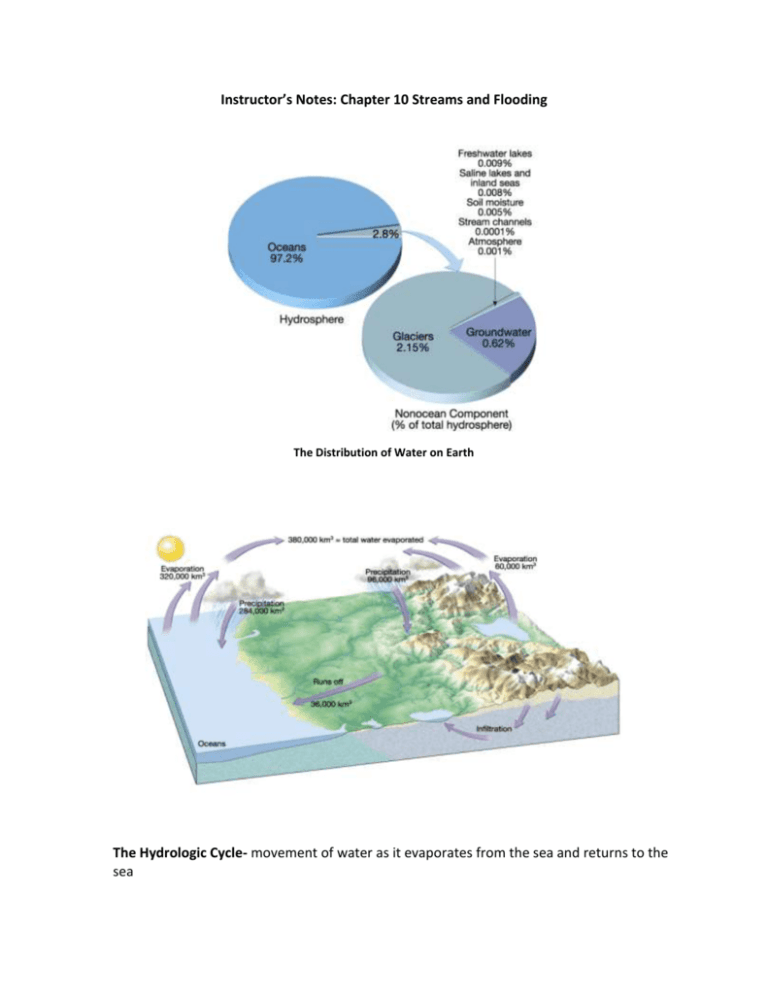
Instructor’s Notes: Chapter 10 Streams and Flooding The Distribution of Water on Earth The Hydrologic Cycle- movement of water as it evaporates from the sea and returns to the sea 15-20% of rainfall becomes surface runoff: Stream- a body of running water confined to a channel moving downhill due to gravity Streams Have Longitudinal Profiles Headwaters- upper part of stream near its source Mouth- where the steams meet the sea, lake, or larger stream Base level-the elevation at which the stream can no longer erode -often found close to the mouth Sheet flow (unconfined flow of water) controlled by: Infiltration capacity- how fast the ground can absorb the water Rainfall intensity- precipitation rates How wet is the soil to start with- if the ground is saturated all rainfall becomes runoff Soil composition and texture- clay rich soil will compact and become impermeable more quickly in comparison to a soil with abundant quartz sand Slope- angle and thickness of sediment Vegetation cover - amount and type of vegetation Streams are constantly trying to reach equilibrium A stream adjusts to channel and profile to changing: Discharge- the amount of water flowing in the stream Erosion- current causes cutting down (vertical) or lateral erosion in a stream channel Base level- elevation to which the stream is flowing Sheet wash- at flood stage, thin layers of un-channeled water flows over a broad area as the stream water exceeds the volume of the channel – this is associated with sheet erosion Stream cross-section: Stream channel-long narrow depression Stream bed- bottom of the channel Stream bank-sides of the channel Drainage Basin- total area drained by a stream and its tributaries 1/3 of US is included in the Mississippi River Drainage basin which includes the Mississippi River and its tributaries the Ohio and Missouri rivers Tributaries-smaller streams that flow into larger streams The Mississippi River is classified as a long stream system where material is eroded at the headwaters in the northern U.S., transported, and ultimately deposited in the Gulf of Mexico. The transported sediments are considered "mature" because during the long period of transportation, most of the minerals weather to clay. The resulting sediment reaching the Gulf of Mexico is resistant quartz grains and abundant clay minerals. In contrast, California Coastal streams are described as short stream systems where the headwaters are not very far from the coastline. The material that is eroded at the headwaters reaches the coastline before it can thoroughly be weathered. The sediment found on these beaches is considered "immature" sediment with mineralogy that can vary greatly (arkosic for example). Royal Gorge in the American River in California drops 375 feet in ¼ mile Drainage Patterns Drainage Patterns (another model) Pedernales Falls, TX Trellis Rectangular Stream Erosion and Discharge Erosion and discharge are controlled by: Water Velocity and Stream Gradient Water Velocity Moderately fast; is 3 miles per hour-flood stage as high as 15 miles/hour Water velocity is directly related to a stream ability to erode and deposit sediment As a stream bends around a curve, the water in the outside of the bend is moving faster and therefore, it erodes. The water on the inside of the bend is slowed down by drag and therefore, it deposits. Steam Gradient Downhill slope of a stream bed- important in controlling steam velocity Stream Gradient = elevation x - elevation y / distance between x and y Example: Royal Gorge 375 ft in ¼ mile =1500 ft /mile gradient Gradient is measured in feet/mile or meters/kilometer Stream gradient is typically greater at the headwaters than at the mouth Rapids indicate local increases in stream gradient Calculation Stream Gradient Stream Discharge: the volume of water that flows past a given point in a unit of time Stream discharge = (stream width x depth) x velocity Stream discharge= x-sectional area of channel x velocity X-section is square meters or square feet Velocity is measured in cubic meters/second or cubic feet/second Climate Effect on Stream Discharge: Humid climates- streams increase discharge downstream because water is added from ground water and tributaries Increase in width and depth of stream downstream Flood discharge can be 50-100 times normal flow Arid Climates- discharge can decrease down river due to evaporation and irrigation Decrease on discharge causes deposition Stream Erosion Hydraulic action- the ability of water to pick up and transport sediment Pothole- holes eroded by abrasion Stream Channel- eroded by abrasion Abrasion- erosion due to friction and impact of sediment within the stream channel- the higher the sediment load of a stream the higher the erosion rate Sediment Transport: Bed load- large particles that travel on the stream bed Traction- rolling sliding or dragging Saltation- bouncing off the bottom Suspended load- light enough to be suspended in the water- generally clay but in flood conditions could be cows, houses and cars! Dissolved load- soluble product of chemical weathering Example: Mississippi River- 750 million tons of material /yr 502 million tons suspended load 195 million tons dissolved load 52 million tons bed load Model of Stream Transport (Figure 10.13) Stream Topographic Features: Bars- ridges of sediment that are deposited when a stream velocity decreases Placer deposits-gold, platinum, diamonds, gemstones, titanium and tin Braided Stream-heavy sediment load Meanders-sinuous curves in a river- associated with late stage river development Point bars- deposition of sediment on inside bend in meander loop Cutbacks- erosion of bank on outside bend in meander loop Meander Cutoffs-short channels across the narrow neck of a meander Oxbow lakes-abandoned meander loop Development of a Meander (Figure 10.20) Flood plains- broad strip of land built up by sediment on either side of a river Natural levees- low ridge of flood deposited sediment Back swamps-low lying area behind a levee Stream terraces- Oxbow Lakes (Figure 10.21) Animations and Movies (Plummer, McGeary, and Carlson) Abandon Channel Fill Deltas- a body of sediment deposited at the mouth of a river when the water velocity decreases Distributaries- channels within a delta that carry water away from the main channel Three Stages of Stream "Evolution": Early, Middle, and Late Early Stage: Stream is well above sea level Erosion is vertical Straight with v shaped valleys, Upgraded streams- waterfalls and rapids Mostly erosion, trying to smooth out variations in gradient Stream gradient decreases through headward erosion and stream capture Middle Stage: Lateral erosion increase and meandering begins Valleys broaden and develop flood plains Waterfalls and rapids disappear Graded Stream- more balance between transport capability and sediment load Late Stage: stream is close to sea level (Coastal Plain) Wide flood plains Oxbow lakes Yazoo rivers Flood Plain and Terraces A single drainage can have early, middle and late stage stream development along its course. Example: Mississippi River Unusual Streams: Superimposed Streams Stream superimposed across narrow mountain ranges Example: Appalachian Cenozoic Uplift Incised Meanders- “goosenecks” Example: San Juan River southern Utah Incised meanders in the San Juan River in Utah- the Colorado Plateau has been subjected to a long period of slow tectonic uplift throughout the Cenezoic. Because of the slow rate of tectoninc uplift the meandering streams were able to cut down without streighten thecourse so the meanders are superimposed in steep canyon ( very unusual). If the tectonic uplift had occurred at a faster rate the streams would have straightened the course and shown early stage stream development. The San Juan river is the tributary to the Colorado River shown on the right edge of this map The Grand Canyon (view with RB glasses) DTM the Grand Canyon Types of Deltas: Stream dominated deltas The stream energy is higher than the sea Bird foot deltas Example: Mississippi delta Wave dominated deltas Energy of the sea is greater than the stream energy Tide dominated deltas Tidal energy is greater than the energy of the stream Stream Deltas Herringbone Cross Beds associated with tidal flats Floods: Stream Floods Flood occurs when a stream overflows its channel Floods cause erosion, deposition and high water Erosion- undercuts banks and levees Deposition -silts and clays beneficial to agriculture High water- devastating in urban areas - Storm sewers are designed for 100 yr flood Flood size is measured by maximum discharge or by stage Flood Size: Maximum dischargeStream discharge = (stream width x depth) x velocity Discharge m3/second Width- meters Depth meters Velocity meters/second Stage- the elevation of the water at the surface Recurrence interval- the average interval of time between floods of a particular size A 100 year flood is the largest flood expected to occur within a 100 year period. Each year there is a 1 in 100 chance or 1% probability that a flood of the given magnitude will occur. Flood Gaging Station Flood plain zones are based on recurrence intervals, and a stream’s flood plain is mapped using for example 25, 50, 100 year flood levels. Insurance premiums are based on flood plain maps and are therefore based on recurrence probability Flash Floods: Localized rapid rise in stream levelCommon in steep stream valleys that receive large amounts of water is short period of time Common in deserts and coastal mountains with large amounts of rainfall in a short periods of time Video: Flash Flood Video: Flash Flood Pedernales Falls, TX Flash Flood Warning System Controlled Floods: Levees and Dams Bypass- example Mississippi River bypass of flood waters to Lake Pontchartrain Non-structural approaches (abandon and relocate) Mississippi River Delta: Mississippi “Birdfoot” Delta Mississippi River Birdfoot Delta Mississippi River and Delta Time Line: Shift position over geologic time has allowed for the two hundred mile arc- shifting depositional axis ever 1000-3000 years. Locations of the shifiting Mississippia Delta over the last 3, 000 years Since the 1950 the US Army Corp of Engineers has been battling the Mississippi trying to prevent shifting from its current location to the Atchafalaya River which is currently 13 feet below the dammed Mississippi. 1940 Atchafalaya captures, (through headward erosion), the Red River another tributary to the Mississippi. The increase in discharge allowed the Atchafalaya to downcut its channel. By 1950 when a dam project was started at the headwater of the Atchafalaya, 30% of the Mississippi discharge was flowing through the Atchafalaya River. The Current Achafalaya and Wax River Deltas 1963 the dam was finished – during spring flood events the Atchafalaya Basin was used to divert flood waters causing further downcutting 1973- Unusually high floods caused the dam and lock system to vibrate- -it weighs 200,000 tons. On the outflow side a pothole 100 m (300 ft) deep was eroded. On intake side both guide walls were undercut and collapsed. The dam very nearly survived total collapse. ½ of New Orleans is now below sea level. The entire bank of the Mississippi has concrete levees. The extraction of groundwater behind the levees has increased the sinking of New Orleans Lake Pontchartrain- bypass floodwaters diverted into Lake Pontchartrain by series of canels built by the Army Corp of Engineers 2005 Katrina http://www.nasa.gov/vision/earth/lookingatearth/h2005_katrina.html


